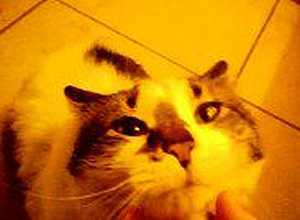The post What’s Causing the Hard Lump on My Cat’s Lower Jaw? (Vet Answer) by Dr. Eric Barchas (Veterinarian) appeared first on Catster. Copying over entire articles infringes on copyright laws. You may not be aware of it, but all of these articles were assigned, contracted and paid for, so they aren't considered public domain. However, we appreciate that you like the article and would love it if you continued sharing just the first paragraph of an article, then linking out to the rest of the piece on Catster.com.
One reader wrote us about finding a lump on her 16-year-old male cat’s chin:
Greetings. My 16-year-old male cat in good health had a rotten molar removed on the upper left side in July. In October I noticed a bone-hard lump, a bit larger than a bubblegum jawbreaker, under his chin on the right side. He enjoys my firmly rubbing it for a few seconds before he pulls his head away.

What are the chances that the lump on the lower right side is related to the surgery of the rotten molar on the upper left side? Could this be a cyst or an osteosarcoma? If so, what is to be done? Can it be slowed down? Does it keep growing? Is he in pain? So far it does not interfere with eating or enjoyment of food, but to sleep, he has to turn his head to the side side. And the look in his eyes is different.
He has a female sibling and they are together a lot. Is she at risk of “catching” what he has?
Thanks, Helen

Because the lump is on the opposite side of the mouth from the affected tooth, odds are slim that the two are related.
Infected teeth can cause swelling of lymph nodes located under the jaw (the submandibular lymph nodes). However, due to the anatomical conformation of the area, generally only the node on the same side as the infected tooth will swell.
The lump may still be a lymph node — it might be reacting to something that’s happening on the other side of the face. Or, more perniciously (and less likely), the node could be infiltrated with malignant cells (cancer).
It’s also entirely possible that the lump is not a lymph node. In that case, you have correctly guessed two possibilities: a cyst or a tumor. Osteosarcoma is a type of tumor that is unfortunately very dangerous. However, I am happy to say that they are not common in cats in the area you describe. A benign process is more likely. The lump also could be caused by an infection in the bone or under the skin (leading to a granuloma), or by an aberrant action of the immune system.
This situation definitely warrants evaluation. Your veterinarian should start with a thorough palpation of the site, a comprehensive oral exam, and a careful evaluation of lymph nodes throughout the body. It may be possible to sample the area using fine needle aspiration (similar to a biopsy, but less invasive and less painful).
If the vet can’t reach a diagnosis through these simple tactics, the next step you should consider would be anesthesia for X-rays (a dental radiology unit will be best suited for this purpose) and a possible biopsy. However, these steps only should be performed if your vet feels that they are worthwhile after an initial evaluation.
The post What’s Causing the Hard Lump on My Cat’s Lower Jaw? (Vet Answer) by Dr. Eric Barchas (Veterinarian) appeared first on Catster. Copying over entire articles infringes on copyright laws. You may not be aware of it, but all of these articles were assigned, contracted and paid for, so they aren't considered public domain. However, we appreciate that you like the article and would love it if you continued sharing just the first paragraph of an article, then linking out to the rest of the piece on Catster.com.